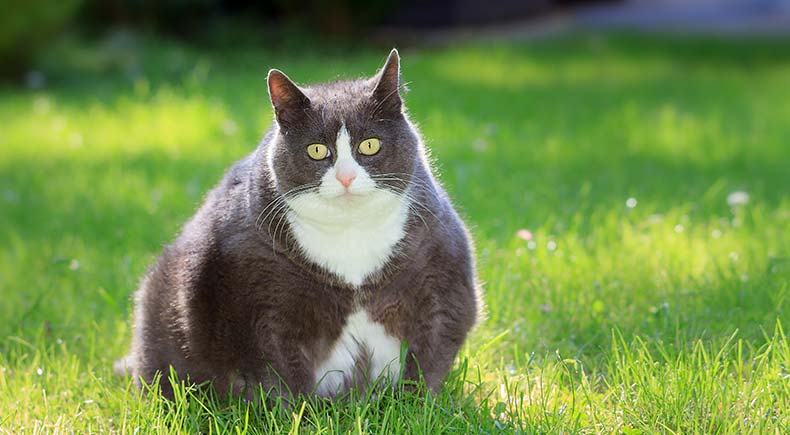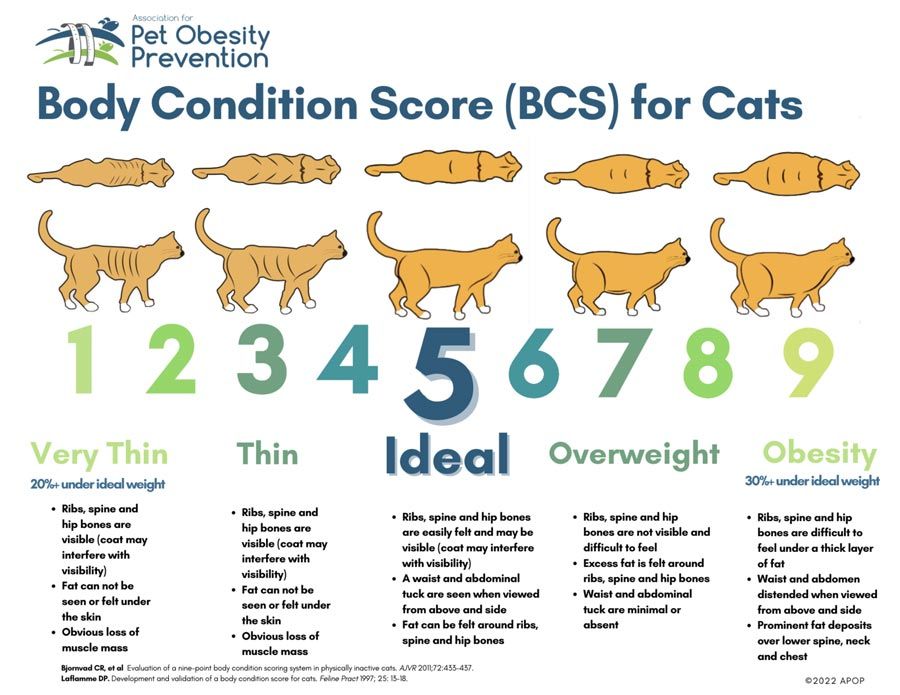Affects Nearly 2 in 3 Cats, yet Owners Can’t See It
Whether pet owners are just in denial or blissfully unaware, this condition has reached an all-time high of 61% among cats. And that's unfortunate as it raises the risk of diabetes threefold, and increases your cat's risk for malignancy, kidney and heart disease, high blood pressure and blindness.

STORY AT-A-GLANCE
- In 2022, 61% of cats were classified as overweight or obese, up from 59.5% in 2021, according to the 2022 Pet Obesity Prevalence Survey
- Many cat owners were unaware that their kitty could use to shed a pound or two
- 28% of cat owners thought their pet’s body condition was "normal" when they were overweight or obese
- 7% of cat owners classified their pet as "normal body condition" when they were actually obese
- Only 49% of respondents said their vet discusses their pet’s weight at their annual visit; if your vet doesn’t, be sure to ask directly whether your kitty’s weight is where it should be
Feline obesity remains a significant problem for U.S. kitties, according to the 2022 Pet Obesity Prevalence Survey, conducted by the Association for Pet Obesity Prevention (APOP). In 2022, 61% of cats were classified as overweight or obese,1 up from 59.5% in 2021.2 Among them, 28% were considered overweight and 33% obese.
However, many cat owners were unaware that their kitty could use to shed a pound or two, and this may be part of the problem. If pet owners don’t know that their companion is overweight or obese, they can’t take the steps necessary to get them healthy.
This is why scheduling regular checkups with your veterinarian is so important, to catch issues like excess weight before it gets out of control. However, according to the survey, only 49% of respondents said their vet discusses their pet’s weight at their annual visit.3 So if your vet doesn’t, be sure to ask directly whether your kitty’s weight is where it should be.
Nearly One-Third of Pet Owners Misclassified Pet’s Weight
In order to determine whether pet owners were aware of their pet’s weight problem, they were asked to classify their pet’s weight as — before being told their actual body condition score (BCS).
"When evaluating body condition on a cat, veterinarians look and feel to determine the fat coverage on a patient and assign them a number on a scale — generally 1-9," Dr. Ashley Navarrette, clinical assistant professor at the Texas A&M College of Veterinary Medicine & Biomedical Sciences, explained.4
"An ideal body condition ranges from a BCS 4-6 with a score of 5 being ideal. We start to get concerned when cats are a BCS 7 and above, which is where we start to label a patient as overweight and progressing toward obese (8 and 9)."5
But according to APOP, "Consistent with our previous surveys, many dog and cat owners fail to recognize excess weight or overweight body conditions in their pets." Their report found:6
- 28% of cat owners thought their pet’s body condition was "normal" when it was actually BCS 6-9 — overweight or obese
- 7% of cat owners classified their pet as "normal body condition" when it was actually BCS 8-9 — obese
To be fair, the APOP report noted, "Accurately assessing feline BCS can be difficult, especially in cats with prominent primordial pouches (belly flaps) or long hair."7 For a visual representation of what a cat should look like at a healthy weight, view this body condition chart provided by the World Small Animal Veterinary Association (WSAVA):

What Are the Risks of Obesity in Cats?
While you may find it tempting to give in your cat’s meows for more treats or food, being overweight can shorten your kitty’s lifespan and reduce their quality of life. Obese cats, for instance, may have less energy and interact less with their families. Further, even a couple of extra pounds increases your cat’s risk of weight-related medical conditions, which include:8
- Type 2 diabetes, which increases threefold in obese cats
- Kidney disease
- Chronic inflammation
- Heart disease
- Osteoarthritis
- High blood pressure
- Many forms of cancer, particularly intra-abdominal cancers
- Bladder and urinary tract disease
- Respiratory disease
- Liver disease
- Reproductive disease
- Blindness due to high blood pressure
- Skin disease
According to the APOP report:9
"Obesity is a physiological disorder affecting numerous body systems. Pet obesity often causes secondary, preventable diseases, including diabetes, osteoarthritis, and many forms of cancer. Professionals and the pet care industry need to educate the pet-owning public better that pet obesity is a disease with significant harmful impacts on both quality of life and life expectancy."
How to Help Your Cat Slim Down
Feeding your kitty kibble? Removing it from their diet is the first step to healthy weight loss. Research shows consumption of dry food is linked to increased obesity risks, both alone and in combination with canned or fresh food.10
Ideally, feed your cat a healthy variety of biologically appropriate foods by offering the least processed, most nutritious options you can. A combination of homemade raw (or gently cooked), commercially available balanced raw, dehydrated/freeze dried raw, and/or human grade canned can help your cat reach a healthy weight.
Be sure to also offer your kitty set meal times with carefully measured portions. Do not free feed your cat, who is an obligate carnivore not biologically made to nibble all day long. And always account for treats in your cat’s daily calories. Treats — even all-meat morsels (the only treats I recommend for cats) — should make up less than 10% of your cat’s daily food intake.
However, any changes to your kitty’s diet should be made gradually so she doesn’t reject the new foods you’re offering. Cats will starve themselves, putting them at risk of hepatic lipidosis, so don’t try to go "cold turkey."
While it takes patience, you can successfully transition even finicky cats onto a healthier diet to help them naturally shed excess pounds.
Sources and References
- 1,3,6 Association for Pet Obesity Prevention, 2022 Surveys & Data
- 2Pet Obesity Prevention March 12, 2019
- 4,5 Texas A&M University, Veterinary Medicine & Biomedical Sciences October 14, 2021
- 7,9 Pet Food Industry May 11, 2023
- 8Pet Obesity Prevention, Weight Reduction in Cats, General Information
- 10bioRxiv January 7, 2020
Today's Pet Video:
Play Time Might Mean It’s Breakfast Time!
Morning rituals are strong in this cat named Pizza! His penchant for going “hunting” under the blankets means it’s time for his human to get up and get his breakfast!











